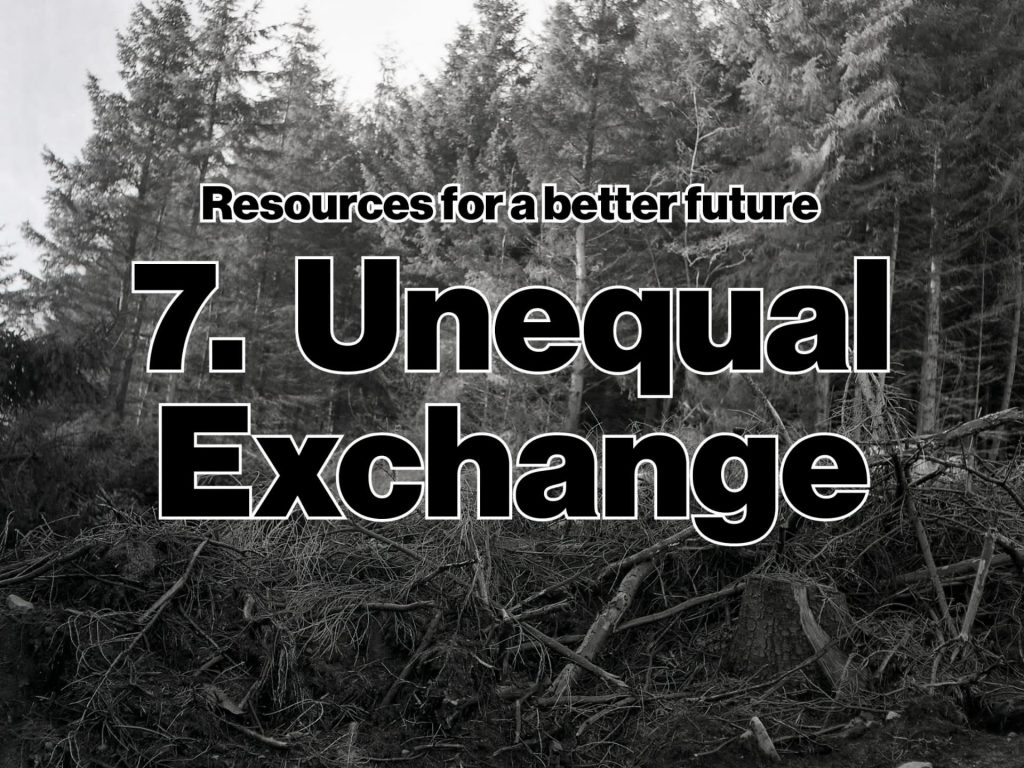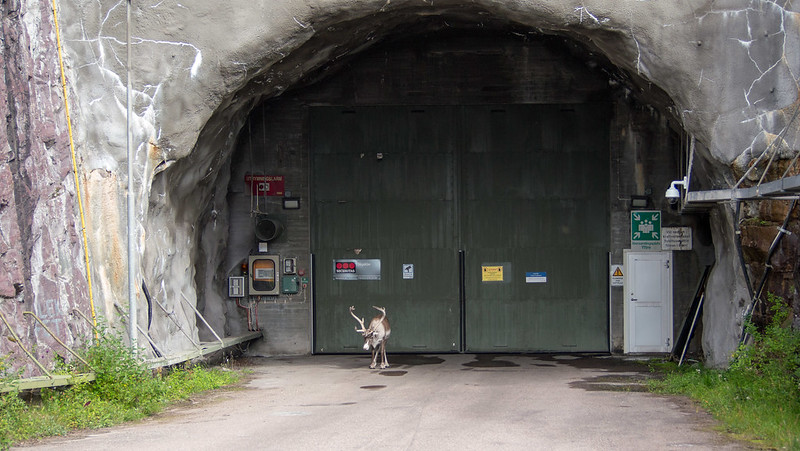
by Rikard Warlenius
The global exchange of commodities and money through trade appear as balanced when we measure it in money, but this conceals very unequal exchanges of labour time, raw materials, and energy and an unequal distribution of Earth’s capacity to absorb environmental waste such as carbon dioxide. These uneven net flows of labour and natural resources and appropriation of sink capacities are what the notion of Ecologically unequal exchange (EUE) conceptualizes, and a common assumption is that they contribute to ecological and human exploitation in peripheral areas as well as to the maintaining of an unjust world order.
Unequal exchange: an academic theory with deep rootlets
The concept has deep rootlets in political economy and ecology. Unequal exchange—basically the notion that more labour is exchanged for less labour through international trade—was discussed by for instance the political economists David Ricardo and Karl Marx in the 19th century, and was later further developed by the Austro-Marxist Otto Bauer, the dependency theorist Arghiri Emmanuel, world system analyst Samir Amin, and neo-Marxist Ernest Mandel, to mention some of the more important contributors. Explanations for why unequal exchange happen vary, from viewing different levels of productivity or wages as the cause to associating unequal exchange with—in more Marxist phrasing—the organic composition of capital. This has to do with the distribution of capital, divided into two categories, in an economy: on the one hand constant capital—investments such as machinery and buildings—and on the other hand variable capital—mainly paid as wages for labour. In advanced, highly industrialized economies, the share of constant capital is normally higher than in ‘developing’ economies. Investments in machines, for instance, substitute for labour and thus less labour is needed to create a certain amount of value. In other words, if a lot of labour time goes into commodity production in one area, like Africa, and much less goes into production in another area, like Western Europe, an exchange of commodities from those two areas is likely give rise to unequal net flows of labour time. The commodity produced in Africa is likely to embody more labour time per unit of value (e.g. dollar) than the European.
Biophysical resources with high exergy (energy with high ability to perform work) are extracted in the peripheries of the world system and exported to the cores, where they are dissipated/consumed
Ecologically unequal exchange: theoretical developments and critical discussions
Starting in the 1980s, the concept of unequal exchange was further broadened to include not only unequal exchange of labour but also of natural resources—matter and energy. A pioneering study was Stephen Bunker’s (1985) Underdeveloping the Amazon, in which theories of unequal exchange were first applied to ecological extraction. Alf Hornborg (1998) coined the concept ecologically unequal exchange and in a series of articles and books gave it theoretical depth by combining world system analysis with thermodynamic concepts from physics. Biophysical resources with high exergy (energy with high ability to perform work) are extracted in the peripheries of the world system and exported to the cores, where they are dissipated/consumed either directly or as inputs to industrial products. From an economic point of view, these final products (cars, cell phones, washing machines …) are considered as more valuable than the input, but from a thermodynamic perspective they are actually of less value. The raw materials have high exergy, with great potentials, that becomes dissipated as it is turned into finished products. The deterioration will then continue as the product is used, worn and finally thrown away. What is more, the low exergy final products are often returned to the peripheries together with waste. According to Hornborg, industrial production is nothing but a displacement of labour, matter, and environmental loads: he regards technology as a mystification of appropriation. The world-economic cores extract labour and high-exergy matter from the peripheries, and spit back waste.
Hornborg has developed a way of assessing and measuring EUE: time-space appropriation (Hornborg 2006). To understand the industrial revolution in England, he quantified the unequal exchange of labour time and hectare yields in the trade exchange of raw cotton and manufactured garments between England and its former North-American slave colonies in the mid 19th century. The result strengthened the idea that England’s superiority was not mainly technological, but rather an effect of its ability to appropriate land and labour from its (former) colonies. Another study has used the same methodological approach to test the global-historical theory that the early modern world system was Sinocentric or polycentric, rather than Eurocentric, and the results seemed to confirm this (Warlenius 2016a). EUE has also been operationalized and applied on more recent statistical data, mainly by the American sociologists Andrew Jorgensen (e.g. 2009) and James Rice, strengthening hypotheses that unequal exchanges maintain a world divided in cores and peripheries.
More recently, attempts have been made to widen the concept to not only encompass the effects of international trade, but of the entire global social metabolism—that is, of societies’ use of natural resources and ecosystems as both source and sink—of which the latter is seldom formally traded. Warlenius (2016b) launched the concept of unequal sink appropriation as a part of the wider notion of EUE and measured how unequally the global carbon sinks, which should be regarded as a ‘common good’, have been distributed historically. In the same article, EUE is linked to another important concept used by the environmental justice movement: ecological debt. Net flows of e.g. natural resources and other commodities, as well as waste and sink appropriation, are referred to as ecologically unequal exchange, while the cumulative stock resulting from these flows are ecological debt. In a similar way, continuous carbon sink appropriation builds up climate debt.
The often quantitative and methodological focus of the concept—its emphasis on the practice of measuring flows of resources—has provoked a critique about EUE being under-theorized. Brolin (2007) advocates a stronger connection to Emmanuel’s theory on unequal exchange, Warlenius (2017) has suggested to employ the Marxist economic geographer David Harvey’s historical-geographical materialism and the concept of uneven development, while Holleman and Foster (2014) suggest a footing on the ecologist Howard Odum’s emergy approach (which basically means to translate all productive inputs—labour, matter and energy—into a unit used to measure energy (e.g. kWh), and use this total “emergy” as a measure of value of a product). Hornborg (2015) has, on the other hand, criticized this latter approach for mixing apples and pears in its attempt to define an objective measure of value: value is culturally produced—people hold different things to be valuable depending on their shared cultural believes—while emergy (as well as land or labour that are the foundation of other materialist theories of value) is physics.
Several of the demands of the environmental justice movements that are related to ecological or climate debt are also relevant to address ecologically unequal exchange
From academia to political movements
While it was the environmental/climate justice movement that developed the concepts of ecological debt and climate debt and these concepts have generated several policy proposals, the background of (ecologically) unequal exchange is academic and used for analysis rather than politics. Yet, linking these concepts together is also a way of building a bridge between environmental justice as academic tradition and as political praxis. Several of the demands of the environmental justice movements that are related to ecological or climate debt, such as the famous outcomes from the 2010 World People’s Conference on Climate Change and the Rights of Mother Earth, are also relevant to address EUE. These include ways of acknowledging the debt as well as repaying it: by reversing unequal net flows through radical emission cuts in high-emitting advanced economies; by compensating peripheral countries in the global South for adaptation costs; through sharing of technologies; and through reparations—concrete transfer of financial resources. Although such global redistribution would mainly be the result of changing balances of power, solid theories and data on past inequalities could encourage struggles for environmental justice.
Further resources
As previously discussed, central texts in the development of theories on ecologically unequal exchange include Bunker (1985), Hornborg (1998 & 2006), Holleman & Foster (2014), and Warlenius (2016b). Brolin (2007) is an encompassing history over the development of the concept unequal exchange, including EUE. Other—much briefer—introductions to the concept are Hornborg’s (2017) chapter in The Routledge handbook of ecological economics and an entry in the online EJOLT glossary. For the latest empirical support for EUE, see this article by Christian Dorninger and colleagues (2021).
Brolin, J (2007): The bias of the world. Theories of unequal exchange. Diss. Lund: Human Ecology Division. Online at: https://lup.lub.lu.se/search/ws/files/4378178/26725.pdf
Bunker, S (1985): Underdeveloping the Amazon: Extraction, unequal exchange, and the failure of the modern state. Chicago: University of Chicago Press.
Dorninger, C et al (2021): “Global patterns of ecologically unequal exchange: Implications for sustainability in the 21st century”. Ecological Economics 179 (pre-print).
Holleman, H & Foster, J (2014): “The theory of unequal ecological exchange: a Marx-Odum dialectic”. Journal of Peasant Studies 41(2) 199-233.
Hornborg, A (1998): “Towards an ecological theory of unequal exchange: articulating world system theory and ecological economics”. Ecological Economics 25(1) 127-136.
Hornborg, A (2006): “Footprints in the cotton fields: The industrial revolution as time-space appropriation and environmental load displacement”. Ecological Economics 59: 74-81.
Hornborg, A (2015): “Why economics needs to be distinguished from physics, and why economists need to talk to physicists: a response to Foster and Holleman”. Journal of Peasant Studies 42(1) 187-192.
Hornborg, A (2017): “Political ecology and unequal exchange”. Routledge handbook of ecological economics. Ed: CL Spash. Abingdon and New York: Routledge. 39-47.
Jorgensen, AK (2009) “The sociology of unequal exchange in ecological context: a panel study of lower‐income countries, 1975–2000”, Sociological Forum 24(1) 22-46.
Rice, J (2007): “Ecological unequal exchange: consumption, equity, and unsustainable structural relationships within the global economy”, International Journal of Comparative Sociology 48(1) 43-72.
Warlenius, R (2016a): “Core and periphery in the early modern world system: A time-space appropriation assessment”. In Jarrick, A, Myrdal, J, & Wallenberg Bondesson, M (eds.): Methods in world history: A critical approach. Lund: Nordic Academic Press.
Warlenius, R (2016b): “Linking ecological debt and ecologically unequal exchange: Stocks, flows, and unequal sink appropriation”. Journal of Political Ecology 23: 364-380
Warlenius, R (2017): Asymmetries. Conceptualizing environmental inequalities as ecological debt and ecologically unequal exchange. Diss. Lund: Human Ecology Divison. Online at: https://lup.lub.lu.se/search/ws/files/19721188/Asymmetries_Introductory_chapter.pdf
Rikard Warlenius is a senior lecturer in Human Ecology at the School of Global Studies, University of Gothenburg. His PhD dissertation (2017) focused on concepts such as Ecologically unequal exchange and Ecological debt. Currently, he is doing research on urban grassroots initiatives for climate transition in Gothenburg and Berlin.
